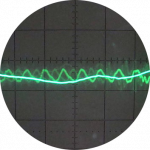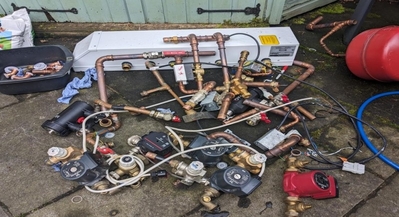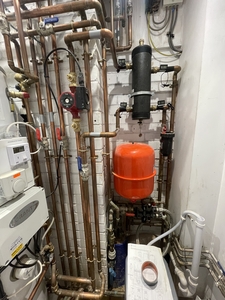@crimson it all depends, on how many rads/ufh are fully open (no actuators or TRVs, a volumiser won't hurt the system (i have 420l worth), that i can bring in and out of my system, but my system i use for testing products.
Is it the older Aerona 3 unit.
Posted by: @crimsonI’m looking at the diagram in the manual and nowhere is there a LLH, item 6 is a volumiser, on the return.
No idea why they’re insisting on the LLH. Should put in a volumiser (80-100 litres) on the return in place of the LLH. Run the flow direct from ASHP to the heating system and DWH, obviously to the valves etc.
And remove the internal pump room pump thats on that, as with no LLH don’t see why would need it.
Very frustrated with these guys.
You are correct you dont need the second pump if there is no LLH/Buffer (unless there is a 'head' problem with your downstream system)
Its entirely understandable that you are frustrated. Sadly, in my work life as well as my home life, I have been there several times with tradespeople of various sorts (but generally plumbers or electricians).
Its very difficult, in my personal experience, to reason with tradespeople who don't understand what they are talking about. There are two ways to rationalise this:
a) conscious incompetence
They know they don't understand what they are talking about, but daren't admit it. So they try to cover themselves by using technoBS. This works on most people because most people are either not capable of challenging them with logical arguments or don't care to do so.
b) unconscious incompetence
They don't even realise that they don't understand what they are talking about So they say what they believe even though its BS. This works on most people because most people are either not capable of challenging them with logical arguments or dont care to do so.
In either case arguing with them is difficult. Perhaps a psychologist would do better than I do, because its probably more a psychological problem than a technical one. Bizarrely its much easier to argue with someone who does know what they are talking about than with someone who doesn't.
That said they all know the power of the pound. Dont pay until you are happy (but make sure you keep a paper trail) but at the same time make sure they remain responsible. Tricky balance, but the one you somehow need to strike as I know you appreciate.
4kW peak of solar PV since 2011; EV and a 1930s house which has been partially renovated to improve its efficiency. 7kW Vaillant heat pump.
I hope out of all of this that I can run the system at a much lower flow temp.
Checked back through endless mails on calcs and it looks like rad wise (this is in addition to ASHP oversizing rads at delta 16.5, so rad output divided by 0.237 for non Eskimo and 0.33 for Eskimo - against the room watt requirements- hence me stating over-oversized as its versus those watt calcs)
Bedrooms range from:
15-115% over-oversized (only the office I like at 21C and thats 115%, others we have at 18C)
Living rooms (Eskimo)
30-45% over-oversized
Still have a main bathroom 14% undersized and an en-suite 24% undersized. But I suspect they’ll be fine as both have electric underfloor in addition to those rads/not really rooms we spend time in.
This makes me glad at least that the rad uplifts works seemed a sound thing to have done.
The substantial oversizing was due to simply doubling heights/K1-K2 changes to minimise non plumbing works (removing skirting/decor etc etc)
So an update…
Installers insist a replacement 80 litre buffer tank/LLH is required.
They’ve sent me a schematic, from Grant Install pack B. And a mail from Grant justifying it:
- Protection against low system volume in oversized or zoned radiator systems
- Balanced flow rates across mixed emitters (radiators, UFH, etc.)
- Improved air and dirt separation when combined with appropriate magnetic filtration
- Compliance with hydraulic separation guidance for heat pump installations
There’s no moving on this it seems.
I’d presume if the zones weren’t actually zoned and everything just left open and balanced down/up etc, it could have avoided needing one.
In good news they’ve agreed to no glycol, no anti-freeze valves, and using the Ferox F1 inhibitor.
They insist the change will work. Will see
Hi @Crimson. Hmm, this isn't surprising. When Grant are pushed they often revert to the default Aerona Schematics, which, by the addition of a lot of un-necessary equipment, are workable. It's only very recently that Grant has acknowledged the option of open circuit installation with their speed controllable pumps in the R290 product range. For the R32 Aerona and fixed speed primary pumps, a low loss header and secondary circulator are included in all their circuit schematics.
The Grant LLH isn't a bad bit of kit, and with careful balancing of primary and secondary flows has little thermal distortion. I would recommend you have a Grant flow setter and indicator valve fitted on the secondary side as well as the primary side, as that's the easiest way to balance the primary and secondary flows. Grant do not show any secondary side flow indication on any of their schematics. Else, you can balance the flows using temperature monitoring across primary and secondary sides.
The LLH allows air to accumulate as it has the lowest velocity in circuit, and there's a decent manual air bleed valve included. It lacks a drain purge valve at the bottom. It follows that if air separates out at the top, dirt and non-magnetic solids will separate out and accumulate at the bottom.
Additional volume: good if needed due to zones or control that can cause the in-circuit system volume to be too low. Helpful with operation when frequently defrosting to avoid the leaving water temperature dropping too low and a sluggish recovery after defrost.
Posted by: @allyfishThe Grant LLH isn't a bad bit of kit, and with careful balancing of primary and secondary flows has little thermal distortion.
... But then what's the point (what value is added in return for the additional cost and risk of poor performance incurred?)
4kW peak of solar PV since 2011; EV and a 1930s house which has been partially renovated to improve its efficiency. 7kW Vaillant heat pump.
@jamespa the point is it allows variable secondary flow rates lower than the primary. In some circumstances that requires hydraulic separation where the primary circulator is a constant volume/head pump. Yes it’s old school, but so are Grant.
Just to be clear this won’t be a Grant LLH/combo volumiser. This will be a 4 port 80L max buffer/LLH. Due to space limitations. They've made no mention of flow setters etc.way back in this thread there are photos of the pump room unlagged however that may show they have something.
I’m not particularly convinced it will resolve the issues, they certainly don't check flow either side, theyve barely observed anything throughout all these issues.
They are installing a Neohun and 2 stats in the living rooms with me granting access for 1 week so they can remote monitor how its gone.
Worse case if doesn't perform they’ll have to convert it from 4 to 2 port and have it only on the return and remove the second pump.
Highly frustrating they’re not open to trying that first but its clearly they do how they do these and no other way, plus its costing them to do this.
Posted by: @crimsonhey've made no mention of flow setters etc.way back in this thread there are photos of the pump room unlagged however that may show they have something.
As you know balancing flow rates is very important. If flow from heat pump < flow to emitters you get significant system distortion (and thus loss of efficiency) because return water finds its way back to the flow thus diluting the temperature. If flow from heat pump >= flow to emitters much less so, but of course it means deltaT on the emitters is higher than it should be/was designed to be which still causes a performance degradation. Best is if the two are equal, but of course thats unachievable without active control and is more or less equivalent to not having a buffer/llh in the first place.
Its clear from your description that your installers dont actually have a clue what they are doing or why, and they are just randomly swapping components in the hope it will work without doing a single calculation or measurement to prove that it will. With a bit of luck you can nudge them in the right direction and this will suffice, but if the temperature/flow loss in the long run is too high, then only an auxiliary pump in that run, repiping it, or turning up the FT to a point which would be unacceptable, will fix it.
4kW peak of solar PV since 2011; EV and a 1930s house which has been partially renovated to improve its efficiency. 7kW Vaillant heat pump.
attached is prelagged in case indicates anything.
I’m extremely frustrated with the builder now as he made a throw away comment that had they installed non Eskimo rads it would have been fine. Had to point out the eskimos were installed as only ones could find that at the height (low windows in those rooms) - had enough watt output to meat the calcs. As the plumbers had stelrad concord lo-lines proposed that didnt even meet the calcs.
finger point central atm
- 26 Forums
- 2,357 Topics
- 53.5 K Posts
- 187 Online
- 6,025 Members
Join Us!
Worth Watching
Latest Posts
-

RE: Setback savings - fact or fiction?
I could, but I think we can do better, by plotting hour...
By cathodeRay , 7 hours ago
-
RE: Midea ASHP – how to set weather compensation
Just one more thought. If you have convenient space fo...
By JamesPa , 9 hours ago
-
RE: Advice on internal circulation pump noise
Extend the primary branch and make sure you have more t...
By ASHP-BOBBA , 10 hours ago
-

RE: External pipework insulation
Oh Dear! that's appalling pipe work, should've been in ...
By dgclimatecontrol , 15 hours ago
-

RE: Jokes and fun posts about heat pumps and renewables
By Morgan , 15 hours ago
-

RE: Controlling Daikin Altherma via P1P2 and Home Assistant
On the contrary, @toodles, that’s a lot of help. I’d ne...
By Majordennisbloodnok , 17 hours ago
-
RE: Octopus Cosy Heat Pump Owners & Discussion Thread
@kevh with the Cosy 6 I know it definitely goes to arou...
By HarrisonC , 1 day ago
-

Parsnip, Bacon & Coconut Milk Soup
First let me say, I am only a cook because I am human a...
By Toodles , 1 day ago
-
RE: Electricity price predictions
Ben Watts posted on LinkedIn that he had updated this w...
By Judith , 2 days ago
-

RE: The good, the bad and the not that great – my heat pump installation
Small update, Emailed and Spoke to Midea UK and they ...
By Burtis , 2 days ago
-
RE: Solis S6-EH1P8K-L-PLUS – Why I Chose It and What I’ve Learned So Far
@bash Octopus does charge for the admin. The process al...
By Batpred , 2 days ago
-
RE: New Fogstar 15.5kWh upright solution
Issues still under investigation by Solis... Fogstar ...
By Batpred , 2 days ago
-
RE: Who's your electricity provider and what's your tariff?
I agree, the consumer is not being properly represented...
By Batpred , 2 days ago
-

RE: Heat Pump Heats the House… But It’s Not Cosy. Emitter Changes or System Tweak?
@toodles interesting suggestion, thanks. I will try to...
By GrahamF , 2 days ago
-
RE: Mitsubishi Ecodan Auto Adaption trial to stop cycling.
The interval you talk of, i think, will be 60min for an...
By F1p , 2 days ago
-
Agree with @majordennisbloodnok on the setbacks. We hav...
By ChandyKris , 3 days ago
-

RE: Speedcomfort radiator fans
@deltona the way the links were added broke the page. A...
By Mars , 3 days ago
-

RE: Refrigerant R32, is it now banned in the EU from 1st Jan 2027 for monobloc ASHPs?
This has been delayed from what I believe to be this ye...
By dgclimatecontrol , 3 days ago






